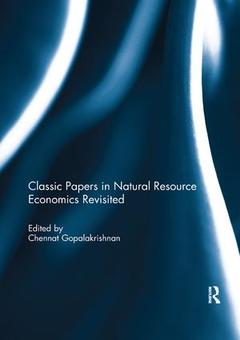Classic Papers in Natural Resource Economics Revisited
Coordonnateur : Gopalakrishnan Chennat

Classic Papers in Natural Resource Economics Revisited is the first attempt to bring together a selection of classic papers in natural resource economics, alongside reflections by highly regarded professionals about how these papers have impacted the field. The seven papers included in this volume are grouped into five sections, representing the five core areas in natural resource economics: the intertemporal problem; externalities and market failure; property rights, institutions and public choice; the economics of exhaustible resources; and the economics of renewable resources.
The seven papers are written by distinguished economists, five of them Nobelists. The papers, originally published between 1960 and 2000, addressed key issues in resource production, pricing, consumption, planning, management and policy. The original insights, fresh perspectives and bold vision embodied in these papers had a profound influence on the readership and they became classics in the field. This is the first attempt to publish original commentaries from a diverse group of scholars to identify, probe and analyse the ways in which these papers have impacted and shaped the discourse in natural resource economics. Although directed primarily at an academic audience, this book should also be of great appeal to researchers, policy analysts, and natural resource professionals, in general.
This book was published as a series of symposia in the Journal of Natural Resources Policy Research.
Introduction Section I: The Intertemporal Problem 1. Uncertainty and the Evaluation of Public Investment Decisions 2. The relevance and the limits of the Arrow-Lind Theorem 3. A reconsideration of Arrow-Lind: risk aversion, risk sharing, and agent choice 4. Evaluating uncertain public projects with rival and non-rival benefits 5. Probing the limits of risk-neutral government 6. Are we in this together? Risk bearing and collective action 7. Evaluation of public investments and individual discounting 8. Rebutting Arrow and Lind: why governments should use market rates for discounting 9. Revisiting Arrow-Lind: Managing Sovereign Disaster Risk 10. Size matters: capital market size and risk-return profiles 11. Microeconomic foundations of bailouts Section II: Externalities and Market Failure – Ronald H. Coase 12. The Problem of Social Cost 13. Battles lost and wars won: reflections on ‘The Problem of Social Cost’ 14. The importance of being misunderstood: the Coase theorem and the legacy of ‘The Problem of Social Cost’ 15. Infringement as nuisance: intellectual property rights and The Problem of Social Cost 16. About some distortions in the interpretation of ‘the problem of social cost’ 17. The successes and failures of Professor Coase Section III: Property Rights, Institutions and Public Choice – Garrett J. Hardin and Elinor Ostrom 18. The Tragedy of the Commons 19. The Core Challenges of Moving Beyond Garrett Hardin 20. Revising the Commons Paradigm 21. Hardin’s Brilliant Tragedy and a Non-Sequitur Response 22. Free Parking at Christmas Is Not a Tragedy of the Commons 23. Guarding the Guardians: Enforcement in the Commons 24. From ‘Tragedy’ to Commons: How Hardin’s Mistake Might Save the World 25. Collective action and the evolution of social norms 26. The collective action theory path to contextual analysis 27. Contextualizing the influence of social norms, collective action on social-ecological systems 28. Collective Action and the Evolution of Social Norms: the principled optimism of Elinor Ostrom 29. Crossing disciplinary boundaries 30. Elinor Ostrom’s challenge for laboratory experiments 31. The evolution of social norms in conflict resolution 32. The evolution of elite and societal norms pertaining to the emergence of federal-tribal co-management of natural resources Section IV: The Economics of Exhaustible Resources – Robert Solow and William Nordhaus 33. The Economics of Resources or the Resources of Economics 34. Reflections on Solow’s The Economics of Resources or the Resources of Economics 35. What Does the Empirical Work Inspired by Solow’s The Economics of Resources or the Resources of Economics Tell Us? 36. What Would Solow Say? 37. Reflections on Solow’s 1974 Richard T. Ely Address 38. The Economics of Resources and the Economics of Climate 39. Celebrating Solow: Lessons from Natural Resource Economics for Environmental Policy 40. The Allocation of Energy Resources 41. Modeling long term energy futures after Nordhaus (1973) 42. The allocation of energy resources in the very long run 43. The world before climate change 44. Energy modeling post 1973 45. The allocation of energy conservation 46. A retrospective on The Allocation of Energy Resource 47. Backstop technology: model keystone or energy systems transition guide essay 48. Caveats for climate policy from Nordhaus’s The Allocation of Energy Resources Section V: Renewable Resources - Paul A. Samuelson 49. Economics of Forestry in an Evolving Society 50. Samuelson’s Economics of Forestry in an Evolving Society: Still an Important and Relevant Article Thirty Six Years Later 51. Reflections on Samuelson’s Economics of Forestry in an Evolving Society 52. Samuelson and 21st Century Tropical Forest Economics 53. Putting Samuelson’s Economics of Forestry in an Evolving Society into Context: The Limits of Forest Economics in Policy Debates 54. Samuelson on Forest Economics: An Inadvertent Tribute to Faustmann, and a Few Others 55. Thoughts on Paul Samuelson’s Classic, Economics of Forestry in an Evolving Society
Chennat Gopalakrishnan is Professor (Emeritus) of Natural Resource Economics at the University of Hawaii, USA. He has published seven books and approximately 115 journal articles and technical papers on current and emerging issues in natural resource economics and policy. He is the Editor-In-Chief of the Journal of Natural Resources Policy Research.
Date de parution : 12-2017
17.4x24.6 cm
Date de parution : 03-2016
17.4x24.6 cm
Thème de Classic Papers in Natural Resource Economics Revisited :
Mots-clés :
Natural Resource Economics Revisited; policy research; USA; public choice; Hold; intertemporal allocation; ISSN; property rights; Energy Resources; externalities; Arrow Lind Theorem; renewable resources; Exhaustible Resource; exhaustible resources; Follow; natural resources policy; North; economics; Ely Lectures; natural resource economics; Coase Theorem; MSY; Violate; Backstop Technology; Discount Rates; Conditional Cooperators; Forest Economics; Optimal Rotation; Samuelson’s Paper; Hotelling’s Rule; Risk Free Rate; Energy Source; Payments; Workshop; Face To Face



